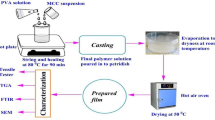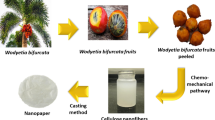Abstract
In the present work, pyrolysis kinetic mechanism was studied for regenerated cellulosic fiber (RCF) and composite RCF containing silicon/nitrogen flame retardants. Limited oxygen index and microscale combustion calorimeter tests show that the loading of nitrogen/silicon into the RCF enhanced flame retardancy. The kinetic triplets of the two kinds of samples were determined by applying iso-conversional methods and integral master plots approach. Compared to the untreated RCF, flame retardant (FR) treated RCF shows enhanced activation energy due to the physical barrier layer due to dehydration of silicate and charring effect resulting from organic–inorganic interaction. Exponential nucleation model can be successful in describing experimental results for RCF in higher conversion degree (0.4–0.9). Simultaneously, the degradation process of FR treated RCF in the main pyrolysis stage (0.2–0.7) is consistent with kinetics of nuclei growth and could be described by one-step reaction whose rate presented an Avrami–Erofeev-type model (n = 2.38).










Similar content being viewed by others
References
Uddin AJ, Yamamoto A, Gotoh Y, Nagura M, Iwata M. Preparation and physical properties of regenerated cellulose fibres from sugarcane bagasse. Text Res J. 2010;80(17):1846–58.
Perepelkin KE. Lyocell fibres based on direct dissolution of cellulose in N-methymorpholine N-oxide: development and prospects. Fibre Chem. 2007;39:163–72.
Calvin W. Regenerated cellulose fibres. Manchester: Textile Institute; 2001. p. 5.
Wang S, Lu A, Zhang L. Recent advances in regenerated cellulose materials. Prog Polym Sci. 2016;53:169–206.
Zhu P, Sui SY, Wang B, Sun K, Sun G. A study of pyrolysis and pyrolysis products of flame-retardant cotton fabrics by DSC, TGA, and PY-GC-MS. J Anal Appl Pyrolysis. 2004;71:645–55.
Kandola BK, Horrocks AR, Price D, Coleman GV. Flame-retardant treatments of cellulose and their influence on the mechanism of cellulose pyrolysis. J Macromol Sci C Polym Rev. 1996;36(4):721–94.
Abdelouahed L, Leveneur S, Vernieres-Hassimi L, Balland L, Taouk B. Comparative investigation for the determination of kinetic parameters for biomass pyrolysis by thermogravimetric analysis. J Thermal Anal Calorim. 2017;129:1201–13.
Bradbury AGW, Sakai Y, Shafizadeh F. Kinetic model for pyrolysis of cellulose. J Appl Polym Sci. 1979;23:3271–80.
Alves SS, Figueiredo JL. Pyrolysis kinetics of lignocellulosic materials by multi-stage isothermal thermogravimetry. J Anal Appl Pyrolysis. 1988;13(1–2):123–34.
Conesa JA, Caballero JA, Marcilla A, Font R. Analysis of different kinetic model, in the dynamic pyrolysis of cellulose. Thermochim Acta. 1995;254:175–92.
Suriapparao DV, Ojha DK, Ray T, Vinu R. Kinetic analysis of co-pyrolysis of cellulose and polypropylene. J Thermal Anal Calorim. 2014;117:1441–51.
Baroni EG, Tannous K, Rueda-Ordonez YJ, Tinoco-Navarro LK. The applicability of isoconversional models in estimating the kinetic parameters of biomass pyrolysis. J Thermal Anal Calorim. 2016;123:909–17.
Alves SS, Figueiredo JL. Kinetics of cellulose pyrolysis modelled by three consecutive first-order reactions. J Anal Appl Pyrolysis. 1989;17(1):37–46.
Burnham AK, Zhou XW, Broadbelt LJ. Critical review of the global chemical kinetics of cellulose thermal decomposition. Energy Fuels. 2015;29(5):2906–18.
Capart R, Khezami L, Burnham AK. Assessment of various kinetic models for the pyrolysis of a microgranular cellulose. Thermochim Acta. 2004;417:79–89.
Lin YC, Cho JM, Tompsett GA, Westmoreland PR, Huber GW. Kinetics and mechanism of cellulose pyrolysis. J Phys Chem C. 2009;113:20097–107.
Sanchez-Jimenez PE, Perez-Maqueda LA, Perejon A, Pascual-Cosp J, Benitez-Guerrero M, Criado JM. An improved model for the kinetic description of the thermal degradation of cellulose. Cellulose. 2011;18:1487–98.
Sanchez-Jimenez PE, Perez-Maqueda LA, Perejon A, Criado JM. Generalized master plots as a straightforward approach for determining the kinetic model: the case of cellulose pyrolysis. Thermochim Acta. 2013;552:54–9.
Abou-Okei A, El-Sawy SM, Abdel-Mohdy FA. Flame retardant cotton fabrics treated with organophosphorous polymer. Carbohyd Polym. 2013;92(2):2293–8.
Moafi HF, Shojaie AF, Zanjanchi MA. Flame-retardancy and photocatalytic properties of cellulosic fabric coated by nano-sized titanium dioxide. J Therm Anal Calorim. 2011;104:717–24.
Horrocks AR, Kandola BK, Davies PJ, Zhang S, Padbury SA. Developments in flame retardant textiles—a review. Polym Degrad Stabil. 2005;88(1):3–12.
Hribernik S, Smole MS, Kleinschek KS, Bele M, Jamnik J, Gaberscek M. Flame retardant activity of SiO2-coated regenerated cellulose fibres. Polym Degrad Stabil. 2007;92(11):1957–65.
Yang ZY, Wang XY, Lei DP, et al. A durable flame retardant for cellulosic fabrics. Polym Degrad Stabil. 2012;97(11):2467–72.
Kivotidi S, Tsioptsias C, Pavlidou E, Panayiotou C. Flame-retarded hydrophobic cellulose through impregnation with aqueous solutions and supercritical CO2. J Therm Anal Calorim. 2013;111:475–82.
Price D, Horrocks AR, Akalin M, Faroq AA. Influence of flame retardants on the mechanism of pyrolysis of cotton (cellulose) fabrics in air. J Anal Appl Pyrolysis. 1997;40–41:511–24.
Poon CK, Kan CW. Effects of TiO2 and curing temperatures on flame retardant finishing of cotton. Carbohyd Polym. 2015;121:457–67.
Zhang KK, Zhong L, Tan YQ, et al. Improve the flame retardancy of cellulose fibers by grafting zinc ion. Carbohyd Polym. 2016;136:121–7.
Dahiya JB, Kumar K. Flame retardant study of cotton coated with intumescents: kinetics and effect of metal ions. J Sci Ind Res India. 2009;68:548–54.
Gann S, Sun G. Effect of phosphorus flame retardants on thermo-oxidative decomposition of cotton. Polym Degrad Stabil. 2007;92:968–74.
Kaur R, Gera P, Jha MK, Bhaskar T. Pyrolysis kinetics and thermodynamic parameters of castor (Ricinus communis) residue using thermogravimetric analysis. Bioresour Technol. 2018;250:422–8.
Farjas J, Roura R. Isoconversional analysis of solid state transformations—a critical review. Part I. Single step transformations with constant activation energy. J Therm Anal Calorim. 2011;105:757–66.
Vyazovkin S, Burnham AK, Criado JM, Pérez-Maqueda LA, Popescu C, Sbirrazzuoli N. ICTAC Kinetics Committee recommendations for performing kinetic computations on thermal analysis data. Thermochim Acta. 2011;520:1–19.
Kissinger HE. Variation of peak temperature with heating rate in differential thermal analysis. J Res Natl Bur Stand. 1956;57:217–21.
Akahira T, Sunose T. Method of determining activation deterioration constant of electrical insulating materials. Res Rep Chiba Inst Technol (Sci Technol). 1971;16:22–31.
Ozawa T. A new method of analyzing thermogravimetric data. Bull Chem Soc Jpn. 1965;38:1881–6.
Flynn JH, Wall LA. A quick, direct method for the determination of activation energy from thermogravimetric data. J Polym Sci Part B Poly Lett. 1968;6(4):323–8.
Starink MJ. The determination of activation energy from linear heating rate experiments: a comparison of the accuracy of isoconversional methods. Thermochim Acta. 2003;404:163–76.
Chen JB, Wang YH, Lang XM, et al. Evaluation of agriculture residues pyrolysis under non-isothermal conditions: thermal behaviors, kinetics, and thermodynamics. Bioresour Technol. 2017;241:340–8.
Qu LJ, Wang ZY, Qian J, et al. Effect of combined aluminum-silicon synergistic impregnation and heat treatment on the thermal stability, chemical components, and morphology of wood. BioResources. 2019;14(1):349–62.
Nassar MM, Fadali OA, Khattab MA. Thermal studies on paper treated with flame-retardant. Fire Mater. 1999;23:125–9.
Ven TVD, Godbout L. Cellulose: fundamental aspects. London: IntechOpen; 2013.
Soares S, Richardo NMPS, Jones S, Heatley F. High temperature thermal degradation of cellulose in air studied using FTIR and 1H and 13C solid-state NMR. Eur Polym J. 2001;37:737–45.
Tejada C, Herrera A, Ruiz E. Kinetic and isotherms of biosorption of Hg(II) using citric acid treated residual materials. Ing. Compet. 2016;18(1):117–27.
Brancatelli G, Colleoni C, Massafra MR, Rosace G. Effect of hybrid phosphorus-doped silica thin films produced by sol-gel method on the behavior of cotton fabrics. Polym Degrad Stabil. 2011;96:483–90.
Horrocks AR. Developments in flame retardants for heat and fire resistant textiles-the role of char formation and intumescence. Polym Degrad Stabil. 1996;54(2–3):143–54.
Zhang MR, Rang GQ, Yao YB, et al. Study on structure and properties of silicon-Nitride flame retardant viscose fiber. Synth Fiber China. 2019;48(6):18–23.
Deka M, Saikia CN, Baruah KK. Studies on thermal degradation and termite resistant properties of chemically modified wood. Bioresour Technol. 2002;84:151–7.
Yorulmaz SY, Atimtay AT. Investigation of combustion kinetics of treated and untreated waste wood samples with thermogravimetric analysis. Fuel Process Technol. 2009;90:939–46.
Gao M, Pan DX. Study on the thermal degradation of wood treated with amino resin and amino resin modified with phosphoric acid. J Fire Sci. 2003;21:189–201.
Zhu FL, Xin Q, Feng QQ, et al. Influence of nano-silica on flame resistance behavior of intumescent flame retardant cellulosic textiles: remarkable synergistic effect? Surf Coat Technol. 2016;294:90–4.
Yao F, Wu QL, Lei Y, Guo WH, Xu YJ. Thermal decomposition kinetics of natural fibers: activation energy with dynamic thermogravimetric analysis. Polym Degrad Stabil. 2008;93(1):90–8.
Acknowledgements
This study was financially supported by the National Key Research and Development Program of China (2017YFB0309001) and the National Natural Science Foundation of China (51576215).
Author information
Authors and Affiliations
Corresponding author
Additional information
Publisher's Note
Springer Nature remains neutral with regard to jurisdictional claims in published maps and institutional affiliations.
Rights and permissions
About this article
Cite this article
Zhu, F.L., Li, X. & Feng, Q.Q. Thermal decomposed behavior and kinetic study for untreated and flame retardant treated regenerated cellulose fibers using thermogravimetric analysis. J Therm Anal Calorim 145, 423–435 (2021). https://doi.org/10.1007/s10973-020-09780-y
Received:
Accepted:
Published:
Issue Date:
DOI: https://doi.org/10.1007/s10973-020-09780-y




